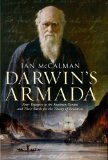Summary | Excerpt | Reviews | Beyond the Book | Read-Alikes | Genres & Themes | Author Bio

Critics' Opinion:
Readers' Opinion:
First Published:
Aug 2009, 432 pages
Paperback:
Nov 2010, 432 pages
 Book Reviewed by:
Book Reviewed by:
Kim Kovacs
Buy This Book
This article relates to Darwin's Armada
The theory of evolution states that all life is related and has descended from a common ancestor; complex creatures evolve over a long period of time from simpler organisms. Evolution is not concerned with the origin of Earth or of the Universe, but attempts to explain why different living things have developed and diversified since life first appeared on Earth.
Evolutionary thought had been around for centuries before Charles Darwin's time;
the first person known to have speculated on the topic was the Greek philosopher Anaximander in the 6th century BCE. Similar pre-evolutionary ideas appeared across Greece, Rome, China, and throughout the Arab world into the Middle Ages. German philosopher Immanuel Kant (1724-1804) and Swedish naturalist Carolus Linnaeus (1707-1778) espoused concepts that anticipated evolution in the mid-1700s. Erasmus Darwin (1731-1802), Charles's grandfather, formulated one of the first formal theories on it in Zoonomia, or, The Laws of Organic Life (1794-1796). He also presented his evolutionary ideas in verse, the best known of which is the posthumously published poem The Temple of Nature:
Organic life beneath the shoreless waves
Was born and nurs'd in ocean's pearly caves;
First forms minute, unseen by spheric glass,
Move on the mud, or pierce the watery mass;
These, as successive generations bloom,
New powers acquire and larger limbs assume;
Whence countless groups of vegetation spring,
And breathing realms of fin and feet and wing.
Darwin's contribution to evolution is the theory of natural selection – the "how" of the theory. It states that evolution occurs by the preservation of an advantage that allows a species to better compete in the wild. As living things reproduce, random mutations occur. If the mutation aids survival, those individuals with this mutation thrive and live to pass on the alteration to subsequent generations; if the mutation doesn't aid survival, the individual is
less likely to reproduce, and that difference is not passed on. Over time, these positive mutations add up, until the resulting creature is so different from its original ancestor that it has evolved into a new species. Wallace further speculated that natural barriers such as mountain ridges or rivers separated populations, thereby fostering additional divergence from the original parent species. Gregor Mendel's work on genetics in the early 1900s expanded on Darwin's theory, helping to explain how such traits are inherited.
Useful Links
Filed under Medicine, Science and Tech
![]() This "beyond the book article" relates to Darwin's Armada. It originally ran in September 2009 and has been updated for the
November 2010 paperback edition.
Go to magazine.
This "beyond the book article" relates to Darwin's Armada. It originally ran in September 2009 and has been updated for the
November 2010 paperback edition.
Go to magazine.





The Flower Sisters
by Michelle Collins Anderson
From the new Fannie Flagg of the Ozarks, a richly-woven story of family, forgiveness, and reinvention.

The House on Biscayne Bay
by Chanel Cleeton
As death stalks a gothic mansion in Miami, the lives of two women intertwine as the past and present collide.

The Funeral Cryer by Wenyan Lu
Debut novelist Wenyan Lu brings us this witty yet profound story about one woman's midlife reawakening in contemporary rural China.
Your guide toexceptional books
BookBrowse seeks out and recommends the best in contemporary fiction and nonfiction—books that not only engage and entertain but also deepen our understanding of ourselves and the world around us.